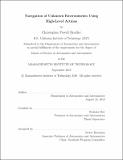| dc.contributor.advisor | Nicholas Roy. | en_US |
| dc.contributor.author | Bradley, Christopher Powell. | en_US |
| dc.contributor.other | Massachusetts Institute of Technology. Department of Aeronautics and Astronautics. | en_US |
| dc.date.accessioned | 2020-03-23T18:09:46Z | |
| dc.date.available | 2020-03-23T18:09:46Z | |
| dc.date.copyright | 2019 | en_US |
| dc.date.issued | 2019 | en_US |
| dc.identifier.uri | https://hdl.handle.net/1721.1/124173 | en_US |
| dc.description | This electronic version was submitted by the student author. The certified thesis is available in the Institute Archives and Special Collections. | en_US |
| dc.description | Thesis: S.M., Massachusetts Institute of Technology, Department of Aeronautics and Astronautics, 2019 | en_US |
| dc.description | Cataloged from PDF version of thesis. | en_US |
| dc.description | Includes bibliographical references (pages 91-96). | en_US |
| dc.description.abstract | Goal-oriented, autonomous navigation through previously unexplored environments presents challenges to a robot on a number of different fronts. First, the robot must construct a representation of its environment that enables it to reason about entering and exploring unknown regions, while still allowing it to backtrack through previously explored space. Additionally, the robot must be able evaluate the expected cost of plans through unobserved space to reach its objective efficiently. This thesis presents work that addresses each of these challenges with respect to a mobile robot. The Learned Subgoal Planner provides an abstraction for planning using high-level actions to reduce the complexity of the planning problem. Using learning to estimate the cost of different actions, a 21% improvement in terms of distance traveled versus a baseline was shown in a simulated environment replicating real-world floor plans. A second contribution is a novel mapping paradigm which represents the world with a graph of actions build from monocular visual input. To construct this map, a convolutional network is used to detect high-level actions from vision. The map is shown to be robust to noise, with particular attention paid to the problem of associating detected actions from frame to frame using a learned association metric. Preliminary results show this metric is an improvement compared to a baseline. | en_US |
| dc.description.statementofresponsibility | by Christopher Powell Bradley. | en_US |
| dc.format.extent | 96 pages | en_US |
| dc.language.iso | eng | en_US |
| dc.publisher | Massachusetts Institute of Technology | en_US |
| dc.rights | MIT theses are protected by copyright. They may be viewed, downloaded, or printed from this source but further reproduction or distribution in any format is prohibited without written permission. | en_US |
| dc.rights.uri | http://dspace.mit.edu/handle/1721.1/7582 | en_US |
| dc.subject | Aeronautics and Astronautics. | en_US |
| dc.title | Navigation of unknown environments using high-level actions | en_US |
| dc.type | Thesis | en_US |
| dc.description.degree | S.M. | en_US |
| dc.contributor.department | Massachusetts Institute of Technology. Department of Aeronautics and Astronautics | en_US |
| dc.identifier.oclc | 1143740779 | en_US |
| dc.description.collection | S.M. Massachusetts Institute of Technology, Department of Aeronautics and Astronautics | en_US |
| dspace.imported | 2020-05-26T23:15:11Z | en_US |
